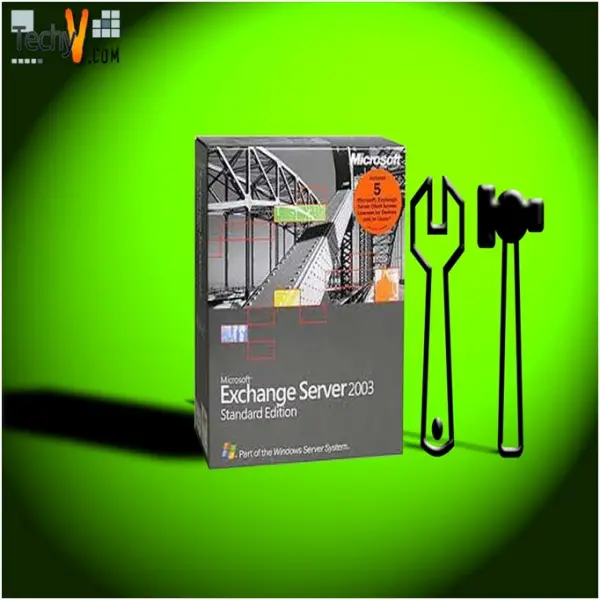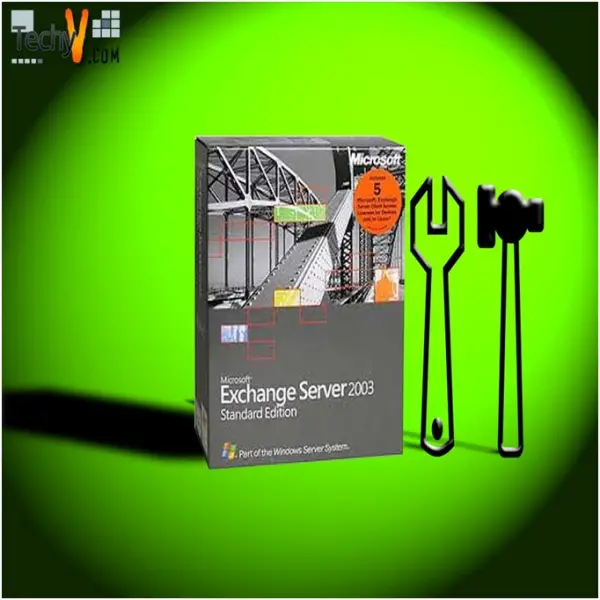All about Exchange Server 2003 Tools – Top 20 Tools
You might have heard of the exchange server 2003 tools, which are in abundance for several different purposes, but perhaps, you’re not yet aware of their unique features, enhancements, how they work and their compatibility with other exchange servers like 2007 and 2010.

Well, this information will be pretty much help for you to locate many of the useful tools for your exchange server whether it is 2003, 2007 or 2010. Following are the 20 most popular Windows Exchange Server 2003 Tools, most of which offer compatibility and other unique features with 2007 and 2010 servers:
20 Best Exchange Server 2003 Tools – How they Work and what Are Their Unique Features?
1. Microsoft Exchange Load Generator
The Microsoft Exchange Server Load Generator offers you the opportunity to inspire more than one MAPI client requests next to the exchange server, which can be tested or benchmarked. This tool is also applicable in production Exchange Organization environments. You can check this tool for the following this:
a. Recognize blocks on your Exchange Servers
b. Confirm a deployment plan for Exchange
c. Authenticate settings and configurations for Exchange Server
Enhancements in Exchange Load Generator
You can avail following enhancements in the Microsoft Exchange Load Generator:
a. Enhanced imitation precision
b. External e-mail addresses and contacts
c. Enhanced scalability
d. Improved mistake retrieval
e. New and enhanced graphical user-interface
f. Different kinds of Outlook clients with no dependency
2. PFDavAdmin Tool
It offers you to rectify public folder permission problems and exportation of public folder permission catalogs. You can employ these tools for:
a. Fundamentally establishing for your users the calendar folder permissions
b. Promoting public folder permissions catalogs below chain of command
c. Administration of the clones of public folders
Moreover, this tool is highly fruitful and is regarded the length of Exchange admin’s lines of his Swiss army blade. Sensible people usually make it a part of their tool kit permanently.
3. Admodify.net – Administration & Recovery of Exchange 2003
This is a superb tool, which can be sued for the administration of Network and Exchange. It also enables size alterations of the Active Directory objects. It is designed by the ‘Exchange Support Services’ team through the utilization of C# .Net 2003. Following are some of the best uses of this tool:
a. Alters Attributes
b. Recovers from a hardware failure
c. Has Undo Attributes
d. Adds bulk of users to Mailbox ‘Rights’
Moreover, its latest version carries amazing undo feature, which allows administrators to modify and roll back bulk all at once.
4. EXINFO tool
This tool can be used to locate and portray Exchange Server 2000 & 2003 information. It was first developed for Exchange 2000 Server and was then enhanced for Exchange Server 2003.
Primarily, it is pretty petite Visual Basic app, which can be run locally on any Exchange 2000 or 2003 server and it’ll offer you the system-state and diagnostic information concerning the Exchange Server along with a bulk of linked Active Directory data. ExInfo employs WMI, which is proper up by Windows 2000, XP, Server 2003, and few other traditional OS as an Add-on feature. Finally, it has three basic operations i.e. locating file and data and customized scripting. It can also be used for CAB file development, as it has enhanced command line syntax.
5. JetStress Tool
This tool works pretty well with the GUI version of JetStress 2004 tool. It usually addresses the Exchange server’s most critical areas, which we call the ‘storage subsystem.’ Basically, it assists you to authenticate the operation and constancy of your disk subsystem> It does this by inspiring few healthy loads to the disks. This tool along with the JetStress together is used to authenticate that the disk subsystem is meeting the set operation criteria.
It furthermore enables you to perform 4 kinds of tests i.e. the Disk Performance, Disk Subsystem Stress and Streaming Backup Tests. The latest updated package of JetStress offers two different apps, such as the JetStressUI.exe and JetStress.exe. Before using this tool, you’re advised to carefully read out its manual, ‘JetStress.doc’.
6. Exchange 2003 Performance Troubleshooting Analyzer Tool – ExPTA
It locates Exchange configuration information with various operation caterers and other data from an Exchange server. It further analyzes every Exchange & Server subsystem to verify blockage before aggregating the data to offer fruitful information concerning these blockages. Finally, it displays few solutions to enhance operations. It requires MS Windows 2000 (Professional), XP, 2000 or 2003 Server with a PC processor higher than 1 GHz and minimum 256 MB of RAM.
It further requires almost 2 MB of free space on each server along with the 10 MB HDD space. You system must have a VGA or high resolution monitor. Finally, it requires Mouse and other compatible input devices along with blended or native modes of Exchange Server 2000 and 2003 with MS Dot net Framework 1.1 IIS common files to operate.
7. Exchange 2003 Disaster Recovery Analyzer Tool – ExDRA
When we talk of this tool, it locates configuration and header information from the transaction log files and Exchange catalogs. It analyzes all catalog headers and resolves various issues with your Exchange database. It mainly requires MS Win 2000 (Professional), XP, 2000 or 2003 Server with PC processor higher than 1 GHz, RAM 256 MB or above and 10 MB HDD and 2 MB server space.
You must have a high resolution monitor with mouse and other compatible devices plus blended or native Exchange Server 2000 or 2003. Finally, it requires you to depend upon the MS .Net Framework version 1.1 IIS common files to run the operations properly. This very first version 1.0 of ExDRA 1.0 offers loads of capabilities to the administrators in order to retrieve their data in case of disasters.
Moreover, this tool is well-practiced among administrators all over the globe who use to recover data and manage storage groups to finally get all the mailboxes back online with the help of this tool.
8. Exchange Monitor 2003 Tool
This free little tool by Jeffery Hicks has the tendency to monitor not only the Exchange servers, but also the processes running on them. It can also start, stop and even restart these Exchange processes and it helps you enable as well as disable each process as per your desires. It also carries a special plus version with extra features and functionalities.
Apart from administrative credentials, this tool requires Windows XP, 2000, 2003 with Exchange servers like 2000 or 2003 and ‘800×600’ screen resolution or higher to run the processes properly. This tool was developed with an intention to running it from an administrators’ Exchange workstation, but you can also runs it on your server too.
9. Offline Address Book Integrity (OABInteg) Tool
It is primarily a nifty petite command line portraying tool developed by Dave Goldman, which basically acts as a utility to assist you fixing OAB generation problem. It can also be helpful while dealing with Outlook clients having issues downloading an ‘OAB’ from a ‘Public Folder’ store online.
It offers the following unique features:
a. Online and Offline Address Lists and their related properties
b. Machine Folders
c. Messages
d. Attachments
e. Hierarchy of the Address List, its recipients and their information
10. NoMAS Tool
This tool has been extensively used by the newsgroups and it offers the following features:
1. Log Entry for 9548 Event
2. Fixtures
3. Modes
4. Enhanced Performance
It’s a simplified tool that fixes problems related to your Exchange servers. You can check your logs for identify the 9548 event log entries to get your NoMAS tool copy to fix them on the spot. It works quite well as compared to the Microsoft Operations Manager (MOM).
11. Disclaimer Fun
As we know that almost every corporal e-mail carries a disclaimer, because of certain legal issues, as means of advertising or perhaps because of giving their messages a great look with a disclaimer. Most of the times, it has been noticed that certain organizations add a disclaimer at the end of each message.
They differ in their formats, but usually they carry some legal content, which read like the group or one sending the message has no responsibility for abusing the contents of the message. It also carries a warning concerning any potential recipient to obliterate this message if received by mistake.
Microsoft with the growth of disclaimers’ popularity, decided to offer a method of adding such functionality to Exchange Servers. For this very purpose, they developed a particular DLL, ‘IMSEXT.DLL’ and generally publicized it. The employment of this DLL followed addition of Rich Text Format (RTF) to a particular worth in Windows ‘Registry.’ So, to some extent, it can be said that it is not that user-friendly tool.
12. Scripting Exchange with VBScript and ADSI Tools
It offers you to create and manipulate Exchange Objects in Active Directory by employing Scripting. This tool offers the following unique features:
a. You can move Mailboxes with it
b. It allows you to employ Move Mailbox Scripting
c. It offers you Mailboxes Size
d. You can have Storage Group Dilemma with it and
e. You can move mailboxes by size with it.
Scripts are famous because they’re hard to document and sometimes they take more time on writing as compared to the manual functioning time. They’re way more practical in larger environments where a lot of time is required to manage a huge amount of servers, catalogs, organizational units and users. Such operations can be really well-streamlined and automated with the carefully written scripts employing several various Exchange programming interfaces.
13. Exchange Best Practice Analyzer
Because of the various strange theories concerning best configuring practice of an Exchange Server 2003 deployment in some organization, Microsoft put her efforts to offer every consultant and administrator with a simple method to set up Exchange by employing its recommendations on the top practices.
The Exchange Best Practice Analyzer version 2.0 by Paul Bowden, offered an influential approach towards simple configuration and optimization of your Exchange Server environment through this amazing utility. Make sure that objective of each Exchange Server 2003 implementation is an installation upon the Best Practices. It operates on the patterns of Microsoft Operations Framework (MOF) and IT Infrastructure Library (ITIL). You should run this tool optimize configuration of each of your Exchange environments, as you’ll find it worthy of it.
14. SMTPDIAG Tool
This tool can be used to identify Exchange 2003-related SMTP and DNS issues. It is primarily a diagnostic utility, which that is employed to conclude if Simple Mail Transfer Protocol – SMTP as well as the Domain Name System – DNS are reliably configured to transfer mail to an outside e-mail id.
It requires Windows 2000, Server 2000 and 2003 to run the processes properly. This troubleshooter is especially created to operate directly from a Win server with IIS or SMTP utility enabled or with some installed version of Exchange Server. It employs similar API's as Exchange and Windows to identify connection as well as configuration problems with the use of DNS and SMTP.
15. MS Exchange Server User Monitor (ExMon) Tool
ExMon is a tool that enables Exchange Administrators to monitor, assess and collect concurrent information concerning users in an Exchange environment. Several reasons reveal that one must employ ExMon in his environment, because the data gathered but this utility helps you as an Exchange Administrator well-comprehends latest user practice patterns and maps further practically and operate proper improvements for future.
It quite comprehensively displays data of your users like an IP addresses employed by them, their outlook mode and versions, CPU usage, total latency for network, Server-side processor latency and operating with Outlook 2003 MAPI network bytes and users.
16. ExMerge
This tool allows you to attach a company or holiday event to entire calendars regardless of transferring a request for meeting. According to the tests performed, this code performs well on ‘Outlook 2000’ with no ‘SP3’ installed. Its latest releases will have the tendency to chunk macros, or ask clients to enable those macros to perform. If it still seems to be a headache, you should better go for a different way, which employs the Exchange ExMerge utility to transfer these events.
17. ISINTEG and ESEUTIL Tools
These tools collectively to make sure health of your date store. Apart from this, ESEUTIL is quite helpful, as it allows you to defragment your Exchange data store while being offline. It can also versify integrity of your store and restore that particular data store in emergency situations.
On the other hand, ISINTEG can be employed to have few tests on the data stores as well as to repair few errors. Before going for any of these tools, you should make it certain that:
a. You’ve created a backup for your Exchange catalogs, even if you believe that the data is corrupted or lost
b. You use these tools after having their proper comprehension
c. You have made it sure that you have performed other entire tests before employing them
d. You have dismounted store
18. ExchMBX
It is a special type of utility that can be used for the purpose of command line-based Exchange Management. Being a moderately experienced Exchange Administrator in the field, if you’ve missed the potential of administering Exchange related assignments through the command line interface (CLI), you still need not to worry about anything else, because ExchMBX is out there to help you at each phase.
One of the Win Server promotion team during the development of MS Win 2003 Server was aimed at providing a CLI alternative for every possible assignment through the Graphical User Interface – GUI, and ultimately, they roughly reached their goals. For instance, any assignment, including Active Directly user object manipulation and DNS administration that can be completed through the unusual AD-related MS Management Consoles – MMCs can be completed via CLI too.
19. IMF Managers
These free IMF add-on utilities enable admins to follow the blocked e-mails, monitor and unblock them, and much more. IMF, which is also known as ‘The Intelligent Message Filter’ was specially designed to be a lenient anti-spam utility for Exchange 2003, as compared to the other utilities. Comparatively, there is a pretty petite to get configured. So, it allows admins to build a confidence level for jamming mails. Moreover, this tool can store jammed e-mails in a directory called ‘archives,’ which is equally browses and located.
20. WinRoute
WinRoute is usually employed to conclude your Exchange organization’s ‘Routing’ status. It is a MS Exchange Server 2000 and/or 2003 utility, which also be employed to conclude the ‘Link State Routing’ – LST – data, which is considered to be a ‘Routing Group Master.’ One can utilize this utility acts as a troubleshooter for the ‘Message Routing’ in environments like Exchange 200x. Such tools connect to the LST, Exchange Server 2003, and TCP port 691. It later extracts the LSI in the shape of an ‘Orginfo packet’ from your organization.
Finally, WinRoute showcases the LSI in a human-friendly and -readable formats. These states offer a ‘tree view’ of your organizational topology and link state as witnessed by a particular host of Exchange 2003. These are established on the stuffing of Orginfo packet, as it also determines name of the routing object GUID's to a human-friendly design, if the utility is capable of get into the Active Directory.














